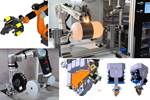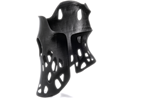Addcomposites introduces structural continuous fiber 3D printing
Large-format 3D printing head is equipped to align and precisely print continuous fiber and chopped fiber formats without compromising on resulting part strength, weight or quality.
Addcomposites (Espoo, Finland) has released its latest large-scale 3D printing technology, structural continuous fiber 3D printing (SCF3D), which employs extrusion-based fused granulate fabrication. The novel printing head for its AFP-XS system aims to solve persistent industry challenges using traditional 3D printing methods.
In the current manufacturing paradigm, industries heavily rely on pure polymer or chopped fiber for printing molds and structural components. However, this method has inherent limitations, particularly in the strength and weight of the final products. Consequently, industries are forced to use excessive material, resulting in bulky and unwieldy parts.
However, by having the capability to integrate continuous fiber reinforcement — ranging between 30-40% — into the printing process, as SCF3D enables, the strength-to-weight ratio of manufactured parts can be significantly enhanced. According to Addcomposites, the technology enables the production of lighter components that are up to 200-240 times stronger compared to conventional methods. Equipped with directional heating and a compaction roller, it can achieve 40% fiber volume fraction with continuous fiber.
One of the pivotal features of SCF3D is its ability to align strength strategically in a predetermined direction, tailored for specific applications. This optimization leads to more efficient and purposeful designs. Additionally, SCF3D features a throughput of 6-9 kg/hr for both continuous fiber and chopped formats, ensuring rapid production without compromising on material use.
SCF3D is complemented by Addcomposites’ software, AddPrint. Drawing inspiration from traditional fiber placement methodologies, AddPrint is specifically tailored for 3D printing applications. It offers optimal freedom in production, enabling precise directional placement of continuous fibers. The software also features digital twin capabilities, enhancing quality control and allowing for comprehensive pre-production simulations. Together, SCF3D and AddPrint enable manufacturers to simulate and visualize production processes in advance, facilitating the alignment and analysis of fibers during the simulation phase to ensure optimal design and account for production limitations.
Learn more about Addcomposites, SCF3D and its ability to further advance automated fiber placement (AFP).
Related Content
-
A new era for ceramic matrix composites
CMC is expanding, with new fiber production in Europe, faster processes and higher temperature materials enabling applications for industry, hypersonics and New Space.
-
3D-printed CFRP tools for serial production of composite landing flaps
GKN Aerospace Munich and CEAD develop printed tooling with short and continuous fiber that reduces cost and increases sustainability for composites production.
-
Carbon fiber, bionic design achieve peak performance in race-ready production vehicle
Porsche worked with Action Composites to design and manufacture an innovative carbon fiber safety cage option to lightweight one of its series race vehicles, built in a one-shot compression molding process.













.jpg;maxWidth=300;quality=90)


